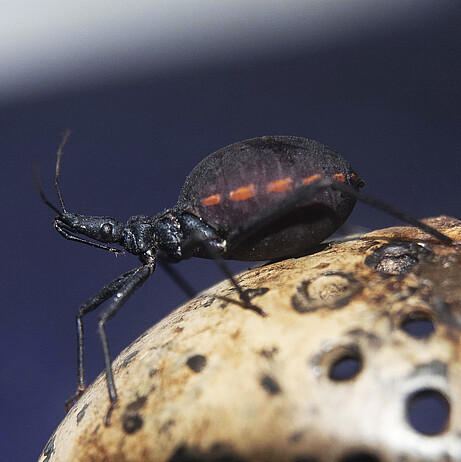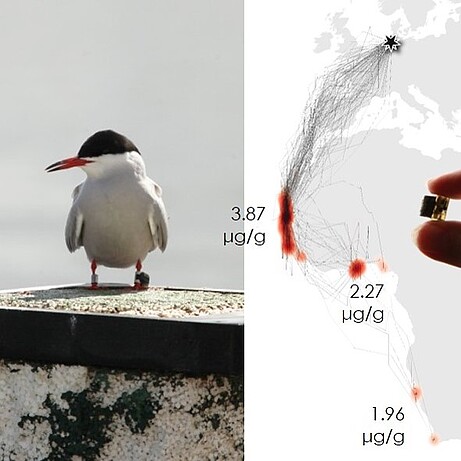

Causes and consequences of mercury pollution
Industrial activities and other drivers of global change, such as ongoing climate warming, increase environmental mercury levels. As mercury enters aquatic ecosystems, microorganisms transform it into its organic and bioavailable form, methylmercury. When biota ingest methylmercury, it can accumulate along the food chain, exposing long-lived top predators, such as some seabird species, to particularly high levels.
We studied the causes and consequences of mercury pollution in the Banter See common terns. Hereto, we collected (i) blood samples from incubating birds (e.g. 1314 samples from 588 birds between 2017 and 2023) using ‘kissing bugs’ specifically bred for this purpose (Becker et al. 2006), as well as (ii) feather samples from birds that were tracked with geolocators or that died of avian influenza (e.g. 1560 samples from 316 birds between 2017 and 2023) and (iii) samples of food items brought into the breeding colony, and analysed them to quantify mercury contamination levels. So far, we have shown that variation in feather mercury levels is explained by where the birds grow these feathers during the non-breeding season (Bertram et al. 2022), and that variation in blood mercury levels during the breeding season is explained by sex, phenology and within-individual accumulation with age (Bertram et al. 2024a), with both also harbouring genetic variation (Bertram et al. 2024b). In addition, we have shown that mercury is transferred across generations, because females transfer mercury to the eggs they lay (Bertram et al. 2025a) and that mercury levels in chicks correlate with their growth, and, therefore, survival (Bertram et al. 2025b). Further work is planned to link mercury levels to immunological parameters and the microbiome, as well as to study its occurrence, in combination with that of other industrial and chemical pollutants, across larger time and spatial scales. In 2026, we will also extend the project by using birds that died of avian influenza to study mercury levels across organs, as well as to investigate whether parasitism by helminths affects levels of mercury (and PFAS) pollution.
Finally, we have studied mercury contamination in the non-piscivorous gull-billed tern as well (Schnelle et al. 2025), and have established causality of the observed pattern of mercury levels in females being lower, and expected to be caused by to transfer to eggs, with experiments on captive Japanese quail (Beccardi et al. 2025).
Publications
Beccardi M, Bertram J, Bouwhuis S, Salmón P, Schupp PJ, Vedder O (2025) Experimental evidence for maternal offloading of mercury pollution via reproduction. Environmental Pollution 385: 127121
Becker PH, Voigt CC, Arnold JM, Nagel R (2006) A non-invasive technique to bleed incubating birds without trapping: a blood-sucking bug in a hollow egg. Journal of Ornithology 147: 115–118
Bertram J, Bichet C, Moiron M, Beccardi M, Kürten N, Schupp PJ, Bouwhuis S (2025b) Mercury levels in chicks of a long-lived seabird – parental effects and links with growth and survival. Environmental Research 285: 122283
Bertram J, Kürten N, Bichet C, Moiron M, Schupp PJ, Bouwhuis S (2025a) Parental blood mercury levels are correlated, and predictive of those in eggs in a long-lived seabird. Environmental Research 275: 121437
Schnelle A, Risch M, Schupp PJ, Liedvogel M*, Bouwhuis S* (2025) Sex- and age-specific mercury contamination in Central Europe’s last gull-billed tern population. Environmental Pollution 374: 126264 (*shared senior authorship)
Bertram J, Moiron M, Bichet C, Kürten N, Schupp PJ, Bouwhuis S (2024b) Mercury concentrations in blood and feathers are repeatable, heritable and correlated in a long-lived seabird. Science of the Total Environment 955: 176939
Bertram J, Bichet C, Moiron M, Schupp PJ, Bouwhuis S (2024a) Sex- and age-specific mercury accumulation in a long-lived seabird. Science of the Total Environment 927: 172330
Bertram J, Kürten N, Bichet C, Schupp PJ, Bouwhuis S (2022) Mercury contamination level is repeatable and predicted by wintering area in a long-distance migratory seabird. Environmental Pollution 313: 120107

